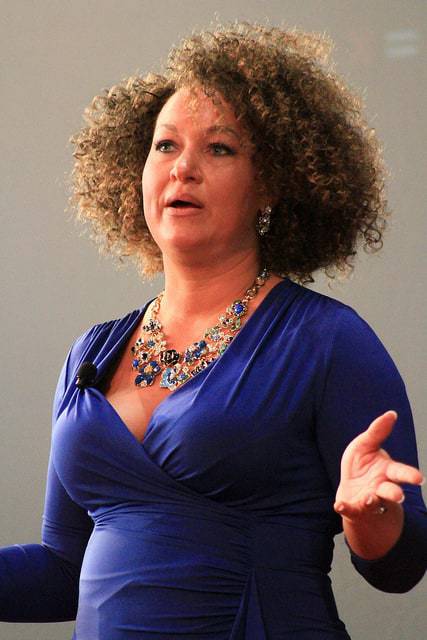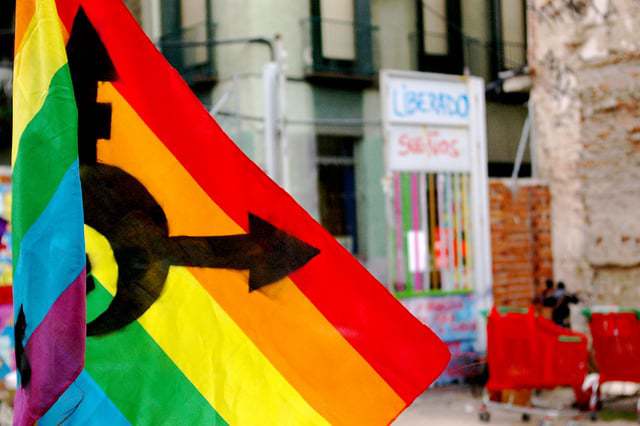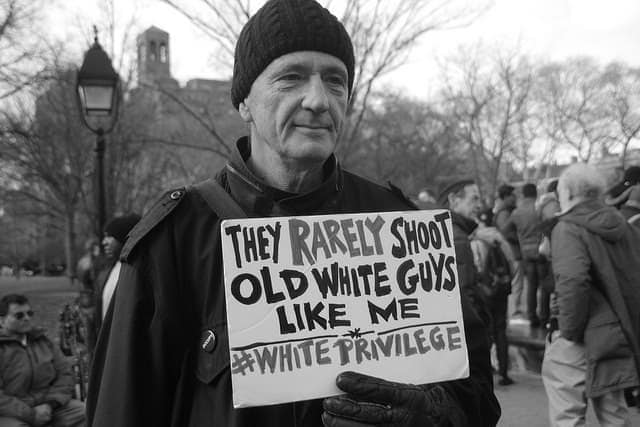In early 2015, I followed the case of Rachel Dolezal, the Spokane woman who attempted to pass as black. She went to considerable length to affirm her blackness – to which she was not born. Once her own parents testified to that effect, she was swiftly denounced and her claims dismissed, with social media playing an important role. Rachel Dolezal became a poster child for something that was ‘not a thing’, as conventional wisdom (i.e.: Twitter) had it: #transracial.
I read many commentaries on this, especially on the tension between transgender and transracial, with the case of Bruce Jenner becoming Caitlyn Jenner being big news at the same time, and vaguely hoped to collate and analyze the debate one day: ethnicity, ‘race’, identity, ascription, subjectivity, constructivism, body, genealogy, many classic anthropological items came together in a perfect storm. I even had a title for my draft, a bad pun nobody else seemed to be making. While I was considering these issues, Rogers Brubaker wrote a book.

Photo by TEDx UIdaho (flickr, CC BY-NC-ND 2.0)
trans is not a long book, and it is not a particularly difficult one. The author does not explicitly state this, but writing and organization (with endnotes and references tucked away in the back) seem geared towards non-academic accessibility. Considering the public interest the Dolezal affair occasioned, such a potential audience surely exists. The public reception of the book, and readings by activists and people personally entangled with the politics of race and gender, will be the actual touchstone for Brubaker’s project: looking at ‘gender and race in an age of unsettled identities’ (as the subtitle suggests). He seems comprehensively informed, he is committedly non-committal, and still – he is an old white man (well: 60) analyzing positions and practices that he has no personal claim to – where angels fear to tread.
He starts with the facile statement that ‘transracial (as opposed to transgender) is not a thing’, a point he returns to throughout the book.
But why is it not?, asks Brubaker, why is the analogy of transgender and transracial so quickly dismissed?
How do the categories gender and race work again?
The first part of the book recapitulates how we got to this point, with a slew of interesting details. Beyond a clear-headed account of the Dolezal affair and the near-simultaneous Jenner transition, we learn that ‘transracial’ used to be solely employed in regards to adoption – specifically, to the problems arising when white Americans adopt children from another ‘race’: how can parents do justice to the children’s ‘heritage’ if they don’t share it? How can they prepare their children to grow up in the world that we have? (Rachel Dolezal’s parents apparently adopted several black children.) To use the term to refer to an individual changing their ‘race’ is a new idea, and, as Brubaker points out, part of the problem with transracialism is that we do not (yet?) have the semantic and conceptual apparatus to express this well.

Such policing of categories never goes away; many drastic examples of how forays across category boundaries are limited or prohibited follow throughout the book. Quite daunting seems the conflict between trans women and certain ‘radical feminists’. The latter refuse to welcome trans women into the category ‘woman’. For them, being a woman is more than having breasts and a vagina and a subjective claim. Being a woman means having had a socially female biography as well, and having made one’s way through a patriarchal world. From this perspective, trans women’s demands to be accepted as women is yet another male imposition. In turn, these feminists are labeled TERFs – ‘trans exclusionary radical feminists’ – and bitter battles are fought over these seemingly irreconcilable positions. The faint of heart better not follow the links Brubaker provides in this section (e.g., p. 122).
Through the rich and empirically (or at least anecdotally) informed discussions of these and other topics (e.g., census forms, whitening creams, gender in sports), Brubaker manages to reconstruct some more formal aspects of the two categories race and gender as well as the dynamics of their social negotiation. They are marked today, he argues, by a high tension between chosen-ness and given-ness that also shapes the (allegedly misplaced) analogy between Jenner and Dolezal.
A neat little four-field matrix (p. 22) in which he plots the question ‘Can one legitimately change one’s gender?’ against ‘Can one legitimately change one’s race?’ demonstrates the political complexities of the struggles over race and gender. A typical position on the left would be the Yes/No quadrant that espouses voluntarism towards gender, but maintains an essentialist position vis-à-vis race. Occasioned by the Jenner/Dolezal brouhaha, some conservatives, seeking to provoke the other side, went full-on ‘if-then’ by demanding equal treatment for both: they claimed that if Jenner had the right to decide her gender, then Dolezal had the right to choose her race as well – an argument likely designed to undermine transgender positions rather than support transracialism, as these conservative voices would surely prefer an essentialist position on both counts, race and gender. By insisting on racial essentialism, so their challenge, the left surrendered its progressive values. Brubaker found few voices genuinely embracing dual voluntarism, the Yes/Yes quadrant, and no commentators at all laid claim to the No/Yes position of gender essentialism and racial voluntarism. Again Brubaker: just why is that so? Why do we have such firm commitments to given-ness and chosen-ness? This firmness is especially intriguing since transgender also has not been ‘a thing’ (i.e., socially and even legally validated) for a very long time either.
One development he points to in this context is the rise of the ‘new objectivism’ (p. 64-65), an increasing willingness to draw on essentialist arguments: to the challenge ‘you can’t just choose to be a woman’ the reply is of course ‘we don’t choose to be women; we simply are women’. This reveals competing essentialisms on both sides. This tension between given-ness and chosen-ness as rhetorical arguments exists regarding race as well – ironically, a genetic test could offer somebody a socially validated claim to blackness even if they never ‘felt black’. So this is where we are: Identities are unsettled, old binaries are going the way of the dodo, a lot of policing and adjudication of claims is going on, and the dust is far from settling.
But here comes the punchline: As trans is different things to different people, and as there are many more than one position on transgender, “trans is not just a social phenomenon to think about; it is also a conceptual tool to think with” (p. 68). The second part of the book explores this “thinking with trans”, to equip us to deal with the analogy of race and gender in a more constructive way than just dismissing it.
Brubaker offers a tripartite heuristic to think about the different modes of trans: the trans of migration, the trans of between, and the trans of beyond.
Each is explored in turn, illustrated again with numerous examples from academic studies as well as more ephemeral sources; but each is also a mode of thinking that Brubaker abstracts from actual transgender dynamics and goes on to project on the question of race. The theoretical advantage is clear: ‘transracial’ as an analogy to ‘transgender’ is partly murky and uncertain because ‘transgender’ already lumps rather different things together. Figuring out the modalities of transgender removes at least the murkiness from the analogy.
The trans of migration is mostly straightforward. It indicates the passage from one established category to another, without subverting or challenging the respective categories. Transitions from man to woman or woman to man fit this model. Thinking about race through the trans of migration reveals that of course there are such transitions, as when people change their legal status or seek to pass as the other, either permanently or intermittently (‘the trans of commuting’). For Brubaker, the main difference to transgender migration seems to be that gender migration is driven by identity, and racial migration by interest, a somewhat tenuous working heuristic. Dolezal and Jenner both fit the trans of migration model, which presents a ‘satisfying narrative form’ (p. 92).
The trans of between sets up new categories. This is an entirely different story, one of emergence, of a new ‘position in a space of possibilities’ (p. 93). Some transgender folk move out of their original category, but never quite settle for the other one. This entails a focus on performativity, enactment, and representation, sometimes involving denied legibility through (re-)combination of male and female traits. In terms of race, the attempts to establish ‘multiracial’ as a socially validated and legal category can be counted as an instance of the trans of between. Racial in-betweenness, then, usually hinges on ancestry, as with ‘mixed children’ – but Brubaker is quick to point out that this suggests the existence of unmixed, putatively pure backgrounds, a problematic notion as well. One problem activists demanding recognition for the category ‘multiracial’ eventually ran into was that their position pitted them against black activists who worried that their constituency would shrink if people selected ‘multiracial’ over the ‘black’ identifier (p. 105). The one-drop rule endures in this and other indirect ways.
Additionally, racial in-betweenness becomes cumbersome over generations, as half-identities become quarter- or sixteenth identities – not a particularly rich and plausible identity claim. The mere performance of in-betweenness, such as ‘voluntary black identity’ by Wiggers (p. 111), is already fraught: it is often seen as appropriation rather than celebration.
Finally, the trans of beyond seeks to overcome existing categories, which is not as easy as it might sound. It breaks down into three further categories: neo-categorical, anti-categorical, and post-categorical. Here, the examples become increasingly idiosyncratic – Brubaker discusses the case of Christie Elan-Cane who pursues an identification as ‘ungendered’. But there is also ‘genderqueer’, which is a (neo-)category, but so underdetermined that it ends up making a mockery of the original binary. The trans of beyond in particular is a fertile field for utopian visions of a post-gendered world (I personally was reminded of the Ancillary book series by Ann Leckie) that again dovetail with some feminist positions. But of course, going beyond genders is quite the opposite of what people pursue in the model of the trans of migration: ‘… the trans of migration presupposes and reproduces gender difference, while transgender projects that seek to carve out a space between or beyond binary gender categories celebrate the liberation and proliferation of previously unimaginable forms of gender difference; they are not assimilationist but hyper-differentionalist’ (p. 122).
While some have sought to make light of existing racial categories by means of parody, this has been proven to be dangerous; but going entirely beyond race is an equally utopian project (a ‘direction of change’, p. 127), as it would require disentangling descent and identity. Some developments point in this direction, but Brubaker is careful not to celebrate just yet – there might be a weakening of racial categories, but not everybody will be equipped (by education, capital, geography) to make use of that.
His conclusion is in principle a summary. The analogy of transgender and transracial should be seen ‘as an intellectual opportunity rather than a political provocation’ (p. 151), an intellectual opportunity that he has very helpfully opened up and made accessible by displaying the complexities and the underlying structures of the field.
Transracial, then, is largely not ‘a thing’ because it is based on ancestry rather than individuality, and individual choice is (in this neoliberal world of ours) something that receives both attention and validation.
His subsequent notes section is tremendously rich.

Photo by gaelx (flickr, CC BY-SA 2.0 )
My draft notes about #transrachel had a subtitle: ‘an addendum to Horace Miner’. This reference to a text that is pointedly as old as Brubaker himself was meant to raise the ethnographic problem of describing taken-for-granted practices and beliefs. This seemed to me particularly relevant in a social field such as this, in which the ‘taken-for-grantedness’ of practices is an explicit goal of an identitarian movement, something that anthropologists are usually happy to deconstruct. Who, I might ask, other than the innocent ontologist, sees it as theoretically progressive to accept the objectivity of subjectivity?
On the other hand, the Nacirema that Horace Miner wrote about live ‘in the territory between the Canadian Cree, the Yaqui and Tarahumare of Mexico, and the Carib and Arawak of the Antilles’ (1956: 503), and this by and large is the region discussed by Brubaker as well. Jesting aside, trans clearly is a book about the United States of America, with few diversions and excursions. France is mentioned as a foil a few times, as is Latin America. Brubaker does mention that the acceptance of transgender is unevenly distributed, but still is speaking about the US – or the global West/North, if we are being generous.
Anthropologically, trans thus ends up still begging a question – the question of culture.
Numerous trans identity claims are products of very particular conditions: these arguments have emerged in a place, at a time, are couched in an idiom, and have their own historical roots. This is true for both gender and the race discussion. In trans, the latter focuses on Blackness in the USA, which matters but hardly covers the full spectrum. Brubaker suggests that the radical celebration of personal self-realization in North America is an important factor. But we still need to learn how transgender travels the globe, and how these identities find (or do not find) social validation elsewhere, and how race works in other places. That challenge is relevant because of the universalist language of both gender and race claims, a language that obviates its own historical positionality. The Dolezal affair is a case in point. It is imbued with US-specific rules and conditions.
Hence, the European reader – off the deep end in Nacirema country – comes away with a new appreciation of the ambivalence of constructivism, and a welcome reminder that while often popular culture is fast, convention is slow, and academia is slowest, sometimes a timely response does come from the university. But in the face of the recent US elections, Twitter users now are jesting that for the next four years, they have decided to become ‘a 35-year old white male’ – under the hashtag #transracial. Rachel Dolezal has a memoir coming out in 2017. And so the unsettling of identities continues. Brubaker’s trans seems a good way to get an empirical overview as well as an abstract understanding of these dynamics.
References:
Miner, Horace 1956. Body ritual among the Nacirema. American Anthropologist 58 (3): 503-507.
Brubaker, Rogers. 2016. trans. Gender and Race in an Age of Unsettled Identities. Princeton University Press. 256 pp. Hb.: $24.95. ISBN: 9780691172354.
**********
Featured image by Chey Rawhoof (flickr, CC BY 2.0)








